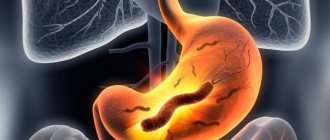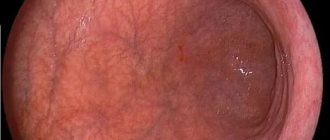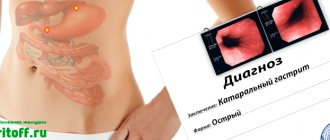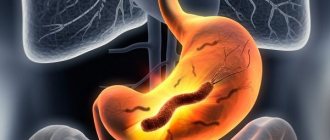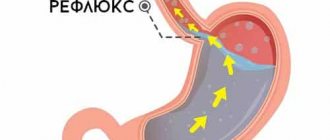Causes of gastritis in adolescents
During adolescence, children and adolescents have a certain predisposition to gastritis. This is often due to irregular diet and other factors.
Treatment in this case is individual in nature and is based on a number of factors. Such as indications for previous treatment, the presence of pylori bacteria in the body of the sick teenager, the general condition of the stomach and the digestive system as a whole.
Risk groups for gastritis include periods from 12 to 13 and from 16 to 17 years in a teenager. During these periods, causative factors favoring the development of gastritis in a teenager are most often observed.
Gastritis in adolescents can develop for a number of reasons:
- The most common cause of gastritis in both adults and adolescents is the bacterium Helicobacter pylori. It appears in the human body for reasons still unclear;
- Eating disorders are also quite common among teenagers. This is associated with the increasing load during this period;
- Junk food, during adolescence the child spends a lot of time away from home. He doesn't always manage to eat healthy foods;
- Emotional stress. The psychosomatics of gastritis can arise due to the first love experiences that teenagers often undergo or due to a small amount of time to rest;
- Physical exercise. Any imbalance in the physical development of a teenager can negatively affect his health, including causing gastritis. This applies to both excess and lack of exercise.
Gastritis can be caused by an aggravated reaction to any food product or an allergy to it.
What kind of disease is this?
Chronic gastritis is a persistent structural change in the gastric mucosa, characterized by local and general disorders, most clearly manifested during exacerbations.
Chronic gastritis usually occurs with a violation of the secretory function of the stomach and is often combined with other diseases of the digestive tract.
According to the International Classification of Diseases, Tenth Revision ( ICD-10 , ICD-10), chronic gastritis belongs to class XI (Diseases of the digestive organs) and has the following codes within the system:
- By 29.3 - chronic superficial gastritis;
- By 29.4 - chronic atrophic gastritis;
- By 29.5 - chronic gastritis, unspecified.
Chronic gastritis in children occurs due to eating disorders, disruptions in daily routine, and nervous experiences. The disease can develop against the background of infection, allergies, other diseases of the digestive system, or due to some congenital characteristics of the body.
Chronic gastritis is diagnosed more often in schoolchildren than in preschool children. This is due to dramatic changes in the nutrition of a child entering a general education institution, as well as a restructuring of the daily routine and emotional overload.
Gastritis in children occurs spontaneously, but is milder than in adults and responds well to treatment.
Forms and types
Based on morphological characteristics, childhood gastritis is divided into the following types:
- Superficial gastritis , which is characterized by damage to the upper layers of the mucous membrane and is accompanied by varying degrees of gastric dysfunction.
- Gastritis with damage to the glands without atrophy is an intermediate stage between superficial and atrophic gastritis.
- Atrophic gastritis , a feature of which is atrophy (depletion, disruption of normal functioning) of the gastric mucosa and a decrease in the number of glands.
- Chronic gastritis in children can occur in an asymptomatic form or a form with severe symptoms.
Symptoms of the disease
Determining the symptoms of gastritis in a teenager is not easy. Children often do not pay attention to the body’s signals, or parents do not take the first complaints too seriously: they often think that the child is trying to beg for an indulgence for studying.
Some of the most subtle symptoms include:
- the child often shudders, has palpitations or increases blood pressure, but not so much as to force you to urgently consult a doctor (within normal limits);
- loss of appetite;
- the teenager complains of heartburn or nausea;
- constant lethargy, drowsiness, fatigue, decreased performance.
More serious signs of gastritis in adolescents that are difficult to ignore even for very inattentive parents:
- the child has constant (or regularly occurring) problems with stool - diarrhea, constipation;
- a teenager is sometimes susceptible to attacks of unexpected vomiting that is not associated with poisoning;
- attacks of severe abdominal pain after eating;
- temperature (low, but still elevated);
- plaque in the mouth is white or yellow.
Any of these symptoms alone could be a sign of another disease, but each of them requires a thorough check of your child's health. A complex combination can cause serious suspicion even before the examination.
Symptoms and signs of the disease
The symptoms of the disease are quite clear, so it rarely goes unnoticed. The presence of two or three of the following manifestations in a child should force parents to consult a doctor:
- hyperthermia, chills;
- nausea, diarrhea, vomiting;
- dry mouth or vice versa, hypersalivation;
- white, yellow or gray coating on the tongue;
- burning or pain in the abdomen;
- loss of appetite;
- heartburn, regurgitation, belching;
- lethargy, restlessness, crying;
- pale skin, bruises under the eyes;
- unpleasant taste in the mouth.
Older children cannot tolerate physical exertion and get tired quickly.
The symptoms of gastritis are very similar to the symptoms of gastroduodenitis in children. Some manifestations of the disease resemble the symptoms of cholecystitis. Only a doctor can reliably determine the presence of a particular pathology.
Symptoms of acute and chronic childhood and adolescent gastritis
Under the influence of negative environmental factors, children may develop symptoms of acute gastritis. This inflammation of the gastric mucosa is most often provoked by the consumption of low-quality products. In adolescents, the main reason for the development of this type of disease is also the presence of “infected” foods in the diet. The smallest boys and girls can accidentally swallow drugs that are toxic - for example, potassium permanganate or any household chemicals.
This quite often becomes the cause of symptoms and further consequences of childhood and adolescent gastritis - in some cases, a burn of the mucous membrane is even possible.
Depending on how much the mucous membrane suffers, doctors talk about different degrees of severity of the disease:
- The inflammation is superficial.
- Deep inflammatory process.
- Inflammation with the formation of small erosions.
- Pathology with visible destructive changes in the mucosa.
Each of these forms is characterized by its own signs of the development of gastritis in a child and adolescent. Vomiting attacks can be observed in cases where children have superficial inflammation - then this symptom is most often one-time. If doctors make a diagnosis in which noticeable destructive changes are noted, then vomiting can torment the child constantly. A similar situation occurs with pain: acute gastritis is literally always accompanied by severe spasms. A decrease in activity in a child is observed in cases where the course of the disease is characterized by constant dehydration due to regularly recurring bouts of vomiting.
Depending on the severity of the symptoms of acute gastritis in children, appropriate treatment is selected. That is why the superficial inflammatory process, which does not threaten the health of young patients, does not require close attention from doctors. But in cases where destructive changes occur, the question most often arises of hospitalization, since the child’s life is at risk: we are talking about possible internal bleeding and severe intoxication.
The chronic form of gastritis in children is characterized by a much longer course and the absence of obvious manifestations. Despite the mild symptoms of the disease, this type is dangerous due to sudden exacerbations. It should be noted that the disease develops against the background of disturbances in the functions of the stomach: in addition, there is also a strong decrease in the protective properties of the mucous membrane.
Long-term stagnation of gastric juice causes the development of a chronic form of the disease. That is why there is such a phenomenon as self-digestion, which provokes the inflammatory process. As in young children, chronic gastritis that occurs in adolescents requires adherence to a mandatory strict diet - small regular meals, healthy food - which is necessary for the patient’s speedy recovery.
Manifestations of acute gastritis
The only type of food that protects against acute gastritis is mother's milk. That is why it is believed that a newborn or infant who is on a natural diet cannot have gastritis in principle . Despite this, unfortunately, there are exceptions here - we will talk about them below. All other food products can provoke it, since they are not guaranteed against the harmful effects of the environment.
If in older children the cause of infection can be poor-quality or contaminated food, then the little one is more “adventurous” in this regard: by chance, out of pure curiosity or for other “noble” motives, the kids may well try the same potassium permanganate, dishwashing detergent or removing cockroaches, rat poison and other nasty things - not to mention medicines in attractive packages.
Contacting the delicate gastric lining, which is not accustomed to such irritants, this substance leads to a burn or an acute inflammatory process. Sometimes it is possible to get by with basic gastric lavage, and in some cases you have to resort to medications. Depending on the intensity of such contact and the degree of damage received, the following manifestations are characteristic of acute gastritis:
- Superficial inflammation occurring in the upper layers. This picture is observed with a moderate degree of the disease with a weak nagging and sometimes bursting pain, stool upset, bloating and gas formation, slight heartburn, and single vomiting. Superficial changes are considered the most common and at the same time do not pose a serious threat to children: having passed the peak of a slight deterioration, the child is cured in just a few days and subsequently forgets about the disease completely - naturally, with proper treatment;
- Deep inflammation penetrating the mucous membrane;
- Small eroded changes of a superficial nature, formed under the influence of inflammation;
- Deep destructive inflammatory processes affecting the mucous membrane.
As for the symptoms of acute gastritis in children in severe form, they manifest themselves primarily: General weakness and a feeling of discomfort. Repeated vomiting can lead to unacceptable dehydration of the child’s body, intoxication and even gastric bleeding, so adults are required to exercise maximum care and caution; Unfortunately, the child almost always experiences pain. These may be stomach cramps, giving off severe pain in the upper peritoneum.
With infectious or viral gastritis, the duodenum is also affected, and parasitic worms or fungi act as pathogens, causing stomach pain, fever, in some cases, a characteristic smell of pus, and lethargy. With phlegmonous gastritis, in addition to severe pain, the child experiences fever, repeated purulent vomiting, the leukocyte count of the blood has a shift to the left, and urine analysis is characterized by leukocyturia and albuminuria.
With a toxic foodborne infection, the gastric mucosa is attacked by pathogens, for example, salmonella and its toxin. Exogenous gastritis is characterized by disruption of the digestive process under the influence of poor-quality food, and with endogenous gastritis, the cause of inflammation is the penetration of etiological agents.
How does chronic gastritis manifest?
The difference between chronic gastritis and acute gastritis lies in the duration of therapy and the mechanisms of occurrence. In addition, the clinical picture of chronic gastritis in children is not so pronounced, and sluggish phases are replaced by periods of exacerbations. How does the disease begin? Due to the weakening of the protective capabilities of the gastric mucosa, its motor and secretory functions are disrupted and it cannot put a barrier to the aggressive environment.
As if sensing that an emergency situation has arisen, the body instinctively uses “internal reserves”: the process of self-digestion of the delicate walls of the mucous membrane with the contents of the stomach occurs - this turns into inflammation. The sensations that arise in this case are unpleasant and are manifested by nausea, belching, heartburn, and a feeling of heaviness. In rare cases, all this may be accompanied by a sharp deterioration in children’s well-being.
Strictly speaking, chronic gastritis manifests itself in two main types of symptoms - gastritis-like and ulcer-like. In the first type, inflammation occurs at the bottom of the stomach, is accompanied by low acidity and is characterized by the appearance of predominantly low-intensity pain immediately after eating, which subside within an hour to an hour and a half. It is logical that such a child suffers from lack of appetite.
In the second type, the source of inflammation becomes the pyloric region with normal or increased acidity, and the pain manifests itself exactly the opposite: after eating, it disappears. Approximately every tenth teenage child experiences night pain. Depending on the state of the secretory function of the stomach (decreased, increased, within normal limits), chronic gastritis can manifest itself in three types. In all cases, the main clinical sign is pain in the epigastric region (located in the middle under the ribs).
The doctor will be able to judge the specific type of disorder only after interviewing the child, during which he must find out: The nature of the pain (most often aching); The time of its appearance (mostly immediately after eating). In this case, the specialist needs to find out what food provoked the pain syndrome. If pain occurs in response to eating spicy food and it decreases after taking an alkaline food, for example milk, we can talk about increased acidity.
If the pain intensifies after eating alkaline foods, it means that the acidity is reduced. Patients often complain of a lack of appetite with a simultaneous feeling of fullness and heaviness in the abdomen; Clinical manifestations in the form of dyspeptic disorders are also possible - nausea, belching, vomiting, heartburn, regurgitation, bowel disorders (alternating diarrhea and constipation).
Headaches, fatigue, irritability and general malaise, which appear in every second patient, indicate asthenovegetative syndrome, and in two thirds, symptoms of autonomic dystonia are obvious in the form of increased sweating, red-resistant dermographism, arterial hypotension, bradycardia, and so on. You should know that with chronic gastritis, hyperemia (increased blood supply) progresses, swelling occurs, and the walls of the stomach can swell on both the external and internal sides, affecting the normal temperature background.
Such negative changes are immediately followed by a reaction from the liver, gallbladder, spleen and pancreas, as a result of which insufficiently digested food accumulates in the large and small intestines with all the ensuing consequences.
Another important point: any chronic disease, including gastritis, becomes the patient’s companion throughout his life, accompanied by periods of exacerbations and remissions (a period without signs of the disease), often of a cyclical nature. When giving a child such a diagnosis, parents must clearly understand this and not indulge him in his desire to violate the regime and menu. In this case, the digestive tract will immediately respond with an “extraordinary” exacerbation.
Superficial, infectious and erosive forms of gastritis in children and adolescents
Another form of this inflammatory lesion is superficial, characterized by a long course and affecting the upper region of the mucous membrane. Quite often it can be accompanied by symptoms such as dysfunction of the stomach, and in addition to this, duodenitis (that is, inflammation of the duodenum) or erosive bulbitis.
Doctors warn that superficial gastritis in adolescents and children can be asymptomatic: a sharp exacerbation occurs when certain external factors act. In these cases, children may experience severe pain in the abdomen after eating, attacks of nausea due to hunger, and lack of appetite. Over time, symptoms such as oral odor, sour taste in the mouth, loose stools, and belching begin to become noticeable.
The infectious form of gastritis in children is distinguished by its rapid development and rapid course. Cases have been recorded when only a few hours passed from the moment the body was infected with pathogenic bacteria until the first symptoms appeared.
Video on the topic:
Doctors ask you to pay attention that in most cases, the cause of this type of illness is the presence of low-quality products in the child’s diet - we are talking about those products that can be contaminated, for example, with salmonella. It provokes the development of infectious gastritis and non-compliance with personal hygiene rules. Experts warn that a complication of this inflammatory process may be a phenomenon such as increasing intoxication.
In adolescents, infectious gastritis requires mandatory drug treatment and is characterized by the following symptoms:
- Constant feeling of nausea.
- Severe pain in the stomach area.
- Fever and lethargy.
Doctors say that a child can vomit for quite a long time and severely - we are talking about uncontrollable attacks. When touching the stomach - palpation - children experience painful sensations. A sign of this disease is a lack of appetite in a small or young patient.
Along with the inflammatory process, the mucous membrane may also suffer from shallow damage called erosions. This indicates that children and adolescents develop erosive gastritis. According to a number of medical studies, it has been found that 5-20% of those people who begin to complain of discomfort and pain in the upper abdomen suffer from this disease.
It has been established that this particular form of the disease is the most severe: the fact is that the already mentioned ulcers can be of varying depths. Most often, the causes of the development of such inflammation are numerous stressful situations - at school and at home, alcohol - in high school students, poisoning with certain chemicals, and neglect of diet. Certain drugs - anti-inflammatory or non-steroidal - can also have a negative effect on the functions of the stomach.
Children with erosive gastritis need constant supervision. In its acute form, this pathology can manifest itself in the form of attacks of vomiting, which contains blood, painful sensations in the upper abdomen, and dark stool. You can also observe such symptoms as paleness of the child’s outer skin, severe heartburn after eating, and indigestion - that is, diarrhea.
Diagnostics: how to determine gastritis of the stomach
If you notice the first manifestations of gastritis in a child, for further diagnosis you need to consult a gastroenterologist. After the initial examination and medical history, the doctor will prescribe additional examinations:
- probing with measurement of the pH of the stomach;
- electrogastroenterography;
- Ultrasound of the peritoneal organs;
- antroduodenal manometry (measurement of pressure in the stomach, duodenum and small intestine);
- laboratory tests: general analysis of stool, blood and urine; stool analysis for H. Pylori;
- blood chemistry;
- endoscopy with biopsy.
It is also important to differentiate gastritis from peptic ulcers, gastroduodenitis and cholecystitis in children.
Diagnostics
Expert opinion
Irina Vasilievna
Practicing gastroenterologist
Diagnosis of chronic gastritis in children is not much different from the diagnosis carried out by adults. A small patient needs to undergo a series of laboratory and instrumental tests, the number and order of which are prescribed by the attending physician.
What is usually included in the examination for chronic gastritis:
- General blood analysis.
- Blood test for antibodies to Helicobacter pylori.
- Stool analysis for Helicobacter pylori.
- Respiratory test for helicobacteriosis.
- PH-metry – determination of the acidity of gastric juice.
- X-ray of the stomach is a research method that allows you to assess the condition of the gastric mucosa.
- Gastric intubation is a diagnostic procedure performed for the purpose of collecting and subsequently analyzing gastric secretions.
- Fibroesophagogastroduodenoscopy (FEGDS) is a method that allows you to see changes in the gastric mucosa: inflammation, hemorrhage, foci of atrophy, etc. When performing FEGDS in children, a biopsy sample is taken in rare cases.
Considering that gastritis in children often occurs against the background of nervous stress and emotional overload, an additional consultation with a neurologist is prescribed.
Treatment of gastritis in children 10-13 years old
After visiting the doctor, you will be prescribed procedures that will confirm the diagnosis: gastroscopy, blood tests. Depending on the research results, treatment for gastritis in children is prescribed: diet, changes in daily routine and some medications.
The diet looks like a list of foods that a child can eat. Successful treatment depends on strict adherence to established rules. The products listed in the prescription do not irritate the gastric mucosa and therefore gastritis changes gradually come into remission.
It is important to understand that no medications or procedures will help without strictly following the diet. Many parents follow their children's lead and make concessions. In this case, the desired result will not be achieved, and exacerbations of gastritis in the child will become more and more frequent.
Among the medications, doctors usually use the following drugs:
- Low acidity is an indication for the use of gastric juice in preparations. The most popular enzymes are Mezim, Festal, Pancreatin.
- Smecta is an excellent absorbent for the opposite problem (high acidity).
- Various vitamins are prescribed to improve the nutrition of stomach tissue.
- To restore damaged stomach tissue, the doctor may prescribe sea buckthorn oil orally, Sucralfate, and mineral waters.
- Severe pain is relieved with analgesics.
Features of the treatment of gastritis in children depend on the severity of symptoms and the type of disease. In case of acute gastritis caused by the ingestion of toxic substances or pathogenic flora into the stomach that provoked poisoning, mandatory rinsing with a tube or drinking plenty of fluids followed by inducing vomiting is indicated.
In case of acute inflammation, the child is prescribed:
- sorbents that absorb and then remove harmful substances from the body (activated carbon, Sorbex, Enterosgel, Smecta);
- antacid drugs to eliminate symptoms, correct acidity levels, neutralize excess gastric acid (Phosphalugel, Almagel, Maalox, Vikalin);
- enzymes to improve food digestion (Pancreatin, Creon, Mezim, Festal);
- antispasmodics to relieve pain symptoms (No-Shpa, Riabal, Meteospasmil, Papaverine, Baralgin).
If the inflammatory process is chronic, gastritis should be treated using:
- antisecretory medications that reduce the amount of hydrochloric acid produced if examination confirms that its normal level is exceeded (Ranitidine, Famotidine, Kvamatel);
- antibiotics and antibacterial therapy if Helicobacter pylori is detected (Metronidazole, Clarithromycin, Amoxicillin, De-Nol);
- histamine receptor blockers (ranitidine, nizatidine, roxatidine);
- antacids (Phosphalugel, Almagel, Maalox);
- medications to improve intestinal motility (Motilium);
- enzymes to facilitate food digestion (Creon, Festal, Mezim, Pancreatin);
- antispasmodics (No-Shpa, Riabal);
- vitamin complexes to replenish the body with necessary substances when absorption is impaired due to inflammation of the stomach.
Only a gastroenterologist should select medications after receiving test results and taking into account the child’s age.
Spa treatment, time in the fresh air, as well as a calm, favorable environment at home will not be amiss for the child.
Drug treatment
An important goal of drug therapy for gastritis is to reduce the aggressive properties of gastric juice. For this purpose, antacid and antisecretory medications are used. They neutralize hydrochloric acid, adsorb harmful substances, enhance the evacuation function of the stomach, relieve spasms, and therefore reduce pain.
These include:
- proton pump inhibitors ( Omeprazole , Rabeprazole , Esomeprazole ) – they block sodium-potassium pumps in parietal cells and are contraindicated in children under 5 years of age;
- histamine receptor blockers type 2 ( ranitidine , famotidine , cimetidine , roxatidine ). They have limited indications in childhood due to the high risk of adverse reactions;
- M-anticholinergics ( Papaverine , No-shpa , Gastrocepin , Riabal ) - often used in children, calculated in mg per kilogram of body weight;
- magnesium- and aluminum-containing antacids ( Phosphalugel , Aktal , Magalfil , Maalox , Protab ). They envelop the wall of the stomach and are used at least 4-6 times a day during the day.
Another goal of drug therapy is to increase the protective forces of the gastric mucosa. For this purpose they cope:
- antibacterial drugs in combination ( Amoxicillin , Clarithromycin , Nifuratel ), they are highly active against Helicobacter pylori infection;
- cytoprotectors ( Liquiriton , Carbenoxolone ) – they protect epithelial cells from damage, promote mucus synthesis and activation of repair processes;
- sucralfate preparations ( Venter , Sucrase ) – form complex compounds in places of inflamed mucosa, thereby protecting it; are allowed in children and have a large number of positive reviews.
In the presence of Helicobacter pylori infection, which most often contributes to the development of superficial gastritis, triple eradication therapy is used in children. It consists of two antibiotics and one antisecretory drug. The optimal duration of such treatment is 7-10 days, after which FEGDS is repeated.
To eliminate the unpleasant symptoms that accompany gastritis, synthetic pancreatic enzymes ( Creon , Pancreatin ), prokinetics ( Domperidone , Domrid) and probiotic agents ( Bifiform , Linex ) are used.
If the disease occurs with frequent vomiting, then it is advisable to prescribe Motilium or Cerucal. The latter drug is more relevant to emergency measures and is most often administered in injection form.
Diet for gastritis in children
Gastritis cannot be cured without changing the child’s diet. Talk to your doctor. This will help you choose a menu that is ideal for your baby. For any form of childhood gastritis, special importance is attached to dietary nutrition. The duration of treatment depends on the severity of the disease and the period of relapse-free progression of chronic processes. Tips for feeding children with gastritis: Partiality, regularity and uniformity of food.
If a child eats not 2-3 times, but 5-6 times a day only at the appointed time, he will accustom the secretory activity of his stomach to absolute self-control. The main thing is to ensure that the portions are not very voluminous. High quality products and gentle on the gastric mucosa. Food must be prepared immediately before eating. Exclude fresh bread made from white flour, raw vegetables, and legumes.
Spicy, smoked, fatty, fried foods with flavoring additives and spices are also excluded. The nature of the child's nutrition. Healthy eating for gastritis in children means steaming or boiling foods. Baked foods are allowed. Food should be soft, mushy, uniform in consistency, slightly above room temperature.
Menu structure. What can a child eat with gastritis?
A diet for gastritis for children contains mashed potatoes, dietary broths from vegetables and rabbit meat, chicken, beef, as well as oatmeal, rice, buckwheat, steamed cutlets from dietary types of low-fat fish and meat, and cottage cheese casseroles.
Drinks: cocoa with milk, rather weak teas, especially herbal teas, dried fruit compote, honey, day-old white flour bread, unsalted crackers. It is especially strictly necessary to adhere to the diet during the acute period of the disease. As the symptoms and signs of inflammation subside, the volume of the diet expands. This is important to replenish lost energy and nutrients.
Treatment of the disease
Children's gastritis can and should be treated.
For this purpose, the following complex of treatment measures is used:
- gastric lavage and sorbents for poisoning (activated carbon, Smecta, Enterosgel);
- gastrocytoprotective medications to protect the stomach from the effects of physical and chemical damaging factors (Maalox, Almagel);
- enzymes (Mezim, Panzinorm, Festal, Creon);
- antispasmodics (No-shpa, Baralgin, Papaverine);
- drugs to reduce the secretion of gastric juice (ranitidine, famotidine);
- antibiotics to eliminate Helicobacter (Amoxicillin, Ornidazole, Metronidazole);
- medications to stabilize gastric motility (Motilium, Cerucal);
- vitamins (Neurobeks, Actovegin).
Throughout the course of treatment for gastritis, children and adolescents must follow a diet. They should eat food in small portions and more often than usual, at least 5 to 6 times during daylight hours. Dishes should only be fresh, mushy, warm and not be greasy, hot, spicy, or too salty. Muffins, fresh white bread, raw vegetables containing a lot of fiber, and legumes should be excluded from the menu of sick children. Children can only drink clean water or mineral water, which the doctor will select for them.
Folk remedies
- Sea buckthorn oil. Sea buckthorn fruit oil, due to its content of vitamins E and B, helps heal wound surfaces and eliminate inflammation. Buy sea buckthorn oil and take 1 teaspoon 2 times a day (in the morning and evening before eating food). Duration of use is 1 month, then you need a break and another 1 calendar month of taking the oil. Sea buckthorn oil is the best remedy for gastritis.
- A decoction of flax seeds. The decoction has a thick consistency due to the oiliness of the seeds. The mucous membrane and walls of the stomach are coated with a decoction, relieving pain and inflammation. Flax seeds contain polysaccharides, which have an antibactericidal effect. They do not have a strong taste or smell. To prepare a decoction of flax seeds to cure gastritis, you need to: pour 1 cup of boiling water into 2 teaspoons of flax seeds. Leave to infuse overnight. Drink 1/3 of a glass of decoction on an empty stomach; the seeds can also be consumed internally - this is very useful. Drink this drink in equal portions throughout the day (2 times). The duration of use of the decoction is 1 calendar month.
- Cabbage juice. Due to its high content of vitamin C, nutrients that help restore the gastric mucosa, cabbage is used to treat ulcerative gastritis. For the first 7 calendar days, drink freshly squeezed cabbage juice 4 times a day, 1 glass. Mix ½ part juice with ½ part glass of water. For the next 7 days, drink juice and water in a 1:2 ratio. From 15 to 21 days of taking the product, take cabbage juice in combination with water in a 1:1 ratio, 2 times a day.
It is recommended that the child be monitored by a pediatric gastroenterologist every 3 months during the calendar year. If relapses no longer affect the baby, then you can see a doctor once every 2 years.
Nutrition for gastritis
Without proper diet, it is almost impossible to cure gastritis. Proper nutrition is based on frequent meals (at least 5 per day) in small portions. You should not give your child food 3 hours before bedtime. Eliminate fried, salty, hot and spicy foods from your diet. Food must be of high quality and steamed or cooked in a slow cooker.
You should refuse:
- sodas;
- juices;
- chips;
- of bread;
- vegetable oil;
- pasta;
- Sahara;
- dried fruits;
- coarse fibrous foods;
- fermented milk products.
Recommended:
- lean types of meat and fish;
- tea;
- porridge;
- boiled or stewed potatoes;
- whole milk;
- casseroles;
- fresh or stewed vegetables;
- fruits (in limited quantities);
- honey;
- nuts.
Exacerbation of gastritis in children and development of complications
If the disease is not diagnosed in time, exacerbation of gastritis in adolescents and children may occur. Experts note that the most unpredictable is the erosive form of the inflammatory process, which for a very long time may not manifest itself in the form of the already described symptoms. Moreover, in medical practice there have been cases when it was the inattention and negligence of parents that caused death.
The development of inflammation of the gastric mucosa can be accompanied by internal bleeding if the disease is not subjected to the necessary treatment. Over time, this phenomenon can lead to a disease such as anemia - that is, low hemoglobin content in the child’s body. As a result, the child’s strength is depleted, and, moreover, cardiovascular functions may be impaired. In addition, against the background of decreased immunity, boys and girls begin to suffer from other diseases more often and constantly experience weakness.
In addition to bleeding, this inflammatory process is dangerous due to the formation of ulcers in the stomach, which are very difficult to treat. It should also be noted that neglect of gastritis in children can lead to the development of malignant tumors. Only treatment of gastritis at an early stage in adolescents and young boys and girls can guarantee a successful outcome.
What is gastritis?
Gastritis is a polyetiological disease of the stomach, accompanied by inflammation of its inner lining. The disease can occur in three forms - acute, chronic and atrophic. Considering that there is hydrochloric acid in the stomach, the disease can occur with an increase, decrease, or normal level of acidity. This is one of the important factors influencing the principle of treatment of children.
A gastroenterologist diagnoses and treats this disease. It is this doctor who will help identify the cause of the disease and give recommendations for the treatment and nutrition of your baby, taking into account his physiological characteristics.
Most often in children there is an acute form of gastritis, which can be treated with medication. With timely treatment, the transition from acute to chronic can be avoided. The children's gastrointestinal tract up to 6 - 7 years of age is at the stage of formation, and inflammation of the mucous membrane can lead to disruption of this process.
